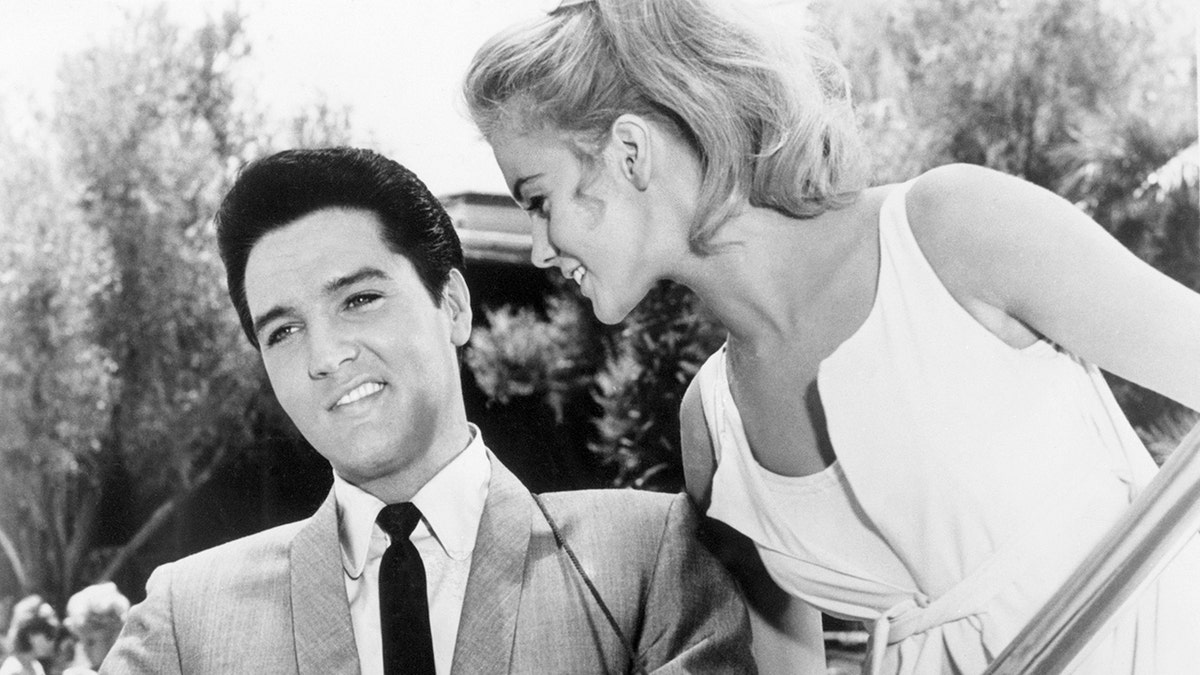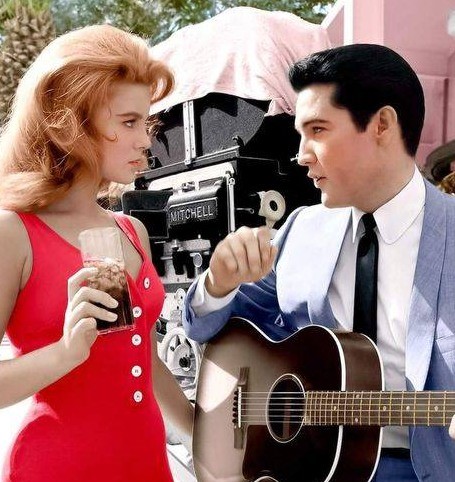Elvis Presley and Ann-Margret on the Set of Viva Las Vegas (1964): A Snapshot of Golden-Era Hollywood Magic
In 1964, a single photograph captured two of Hollywood’s brightest stars at the height of their charm and fame — Elvis Presley and Ann-Margret. Taken during the filming of Viva Las Vegas, this image remains one of the most iconic glimpses into the glamorous, electric world of mid-century American cinema.
The picture shows Elvis, dressed in his classic casual style, standing beside the radiant Ann-Margret, both smiling between takes. Behind their expressions lies a story of artistry, chemistry, and a turning point in Presley’s film career.

A Defining Era for Elvis Presley
By 1964, Elvis Presley was already a global phenomenon. Following his return from military service in 1960, he had starred in a string of successful musical films, including Blue Hawaii (1961) and Girls! Girls! Girls! (1962). These productions cemented his reputation not just as the King of Rock and Roll, but also as one of Hollywood’s most bankable leading men.
Viva Las Vegas, directed by George Sidney and produced by Metro-Goldwyn-Mayer (MGM), represented a peak in that cinematic journey. The film showcased Elvis as Lucky Jackson, a charismatic race car driver with big dreams and a knack for music. The story was simple but filled with energy — a perfect match for Presley’s screen presence and musical talent.

Enter Ann-Margret: A Star on the Rise
Ann-Margret Olsson, a Swedish-American actress and dancer, was 23 when she starred opposite Elvis. Just a few years earlier, she had earned praise for her performance in Bye Bye Birdie (1963), which established her as one of the most promising young stars of her generation.
Her role in Viva Las Vegas as Rusty Martin — a confident, witty swimming instructor — not only complemented Elvis’s charm but also introduced audiences to a leading lady who could match his charisma and energy on screen.
Critics and film historians, including those from Turner Classic Movies (TCM) and The Hollywood Reporter, often describe their pairing as “lightning in a bottle.” Their chemistry was immediate, natural, and magnetic, giving the film an emotional spark that elevated it above many of Presley’s earlier musicals.

The Iconic Photograph
The famous photograph of Elvis Presley and Ann-Margret captures more than just a behind-the-scenes moment — it encapsulates the vibrant energy of 1960s Hollywood.
Shot during production at the MGM backlot and several Las Vegas landmarks, including the Flamingo Hotel and the Fremont Street area, the photo reflects the movie’s dazzling mix of music, romance, and spectacle.
Elvis, in a simple shirt and slacks, appears relaxed and confident, while Ann-Margret radiates warmth and elegance in her costume. Together, they project a sense of youthful optimism that mirrored the mood of America in the early 1960s — a nation in love with glamour, freedom, and rock and roll.
According to the Graceland Archives, Presley’s personal photographer often documented his film shoots, and many of these stills have since become historical records of his artistic career.

Behind the Scenes: Music, Dance, and Connection
Production on Viva Las Vegas took place between July and September 1963, with much of the choreography handled by the acclaimed dance director David Winters. Both Elvis and Ann-Margret were deeply involved in rehearsing musical numbers, which included the now-legendary title track “Viva Las Vegas” — written by Doc Pomus and Mort Shuman — and Ann-Margret’s energetic “Appreciation.”
Insiders from the MGM production team later recalled that the two stars often stayed late after rehearsals, practicing steps or discussing scenes. Their shared dedication to performance and rhythm was one of the reasons their on-screen chemistry felt so authentic.
Film historians have noted that Elvis admired Ann-Margret’s professionalism, describing her as “a natural performer” who brought out his best on camera. Their collaboration resulted in one of the most engaging performances of his movie career.
The Film’s Success and Cultural Impact
When Viva Las Vegas was released in May 1964, it quickly became one of Presley’s highest-grossing films. According to Box Office Mojo and Variety archives, it ranked among the top-earning musicals of the decade, receiving positive reviews for its vibrant performances and catchy soundtrack.
The film’s success also coincided with a pivotal cultural moment: Las Vegas was emerging as a global entertainment capital. Elvis would later make the city his artistic home during his legendary 1970s concert residencies at the International Hotel (now the Westgate Las Vegas Resort & Casino).
The Viva Las Vegas soundtrack — especially the title song — remains one of Presley’s most enduring hits. Today, it’s considered an anthem of the city itself, often played at major Las Vegas events, from sports games to New Year’s Eve celebrations.

Legacy of the Elvis–Ann-Margret Partnership
Though Viva Las Vegas was their only film together, the professional bond between Elvis and Ann-Margret endured for decades. In interviews later published in People and Rolling Stone, Ann-Margret spoke fondly of her collaboration with Presley, describing him as “gentle, funny, and deeply focused on his craft.”
Their shared respect and artistic connection symbolized an era when Hollywood musicals blended charm, music, and emotion in a way that remains timeless.
The photograph from that set day, showing the two smiling effortlessly, continues to circulate among collectors, fans, and museums — including the Elvis Presley Birthplace Museum in Tupelo, Mississippi and the Graceland Exhibition Center in Memphis, Tennessee.
Why Viva Las Vegas Still Resonates Today
More than 60 years after its release, Viva Las Vegas holds a special place in both film and music history. The film captures a moment when two extraordinary performers met at the crossroads of music, dance, and cinematic storytelling.
The city of Las Vegas itself plays a central role, reflecting the optimism, freedom, and spectacle that defined 1960s America. With its vibrant color palette, lively soundtrack, and dynamic performances, Viva Las Vegas remains a joyful reminder of a golden age when movies were designed to make audiences smile, sing, and dream.
And in that single photograph — Elvis and Ann-Margret side by side — we glimpse not just two stars, but the spirit of an era: bold, bright, and forever alive under the neon lights of Las Vegas.
